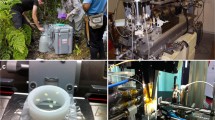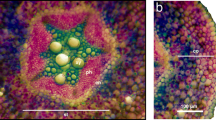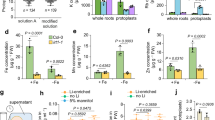Abstract
Laser ablation-inductively coupled plasma-mass spectrometry (LA-ICP-MS) was applied for the determination of Cd and Zn distributions within the leaves of Cd- and Zn-hyperaccumulating plants, Noccaea caerulescens, N. praecox, and Arabidopsis halleri, in contrast to nonaccumulator species, Thlaspi arvense and A. thaliana. The elemental mapping of the selected leaf area was accomplished via line scans with a 110-μm-diameter laser beam at a 37-μm s−1 scan speed and repetition rate of 10 Hz. The lines were spaced 180 μm apart and ablated at an energy density of 2 J cm−2. The elemental imaging clearly confirmed that Cd was predominantly distributed within the parenchyma of the T. arvense, whereas in the Noccaea spp. and A. halleri, the highest intensity Cd signal was observed in the veins of the leaves. For Zn, higher intensities were observed in the veins for all the plant species except for A. thaliana. Close relationships between Zn and Ca were identified for the Noccaea spp. leaves. These relationships were not confirmed for A. halleri. Significant correlations were also proved between the Cd and Zn distribution in A. halleri, but not for the Noccaea spp. For both T. arvense and A. thaliana, no relevant significant relationship for the interpretation of the results was observed. Thus, the LA-ICP-MS imaging is proved as a relevant technique for the description and understanding of the elements in hyperaccumulating or highly accumulating plant species, although its sensitivity for the natural element contents in nonaccumulator plant species is still insufficient.





Similar content being viewed by others
References
Alvarez-Fernandez, A., Diaz-Benito, P., Abadia, A., Lopez-Millan, A. F., & Abadia, J. (2014). Metal species involved in long distance metal transport in plants. Frontiers in Plant Science, 5, 105.
Anselin, L. (1995). Local indicators of spatial association – LISA. Geographical Analysis, 27, 93–115.
Assunção, A. G. L., Ten Bookum, W. M., Nelissen, H. J. M., Vooijs, R., Schat, H., & Ernst, W. H. O. (2003). Differential metal-specific tolerance and accumulation patterns among Thlaspi caerulescens populations originating from different soil types. New Phytologist, 159, 411–419.
Bartels, B., & Svatoš, A. (2015). Spatially resolved in vivo plant metabolomics by laser ablation-based mass spectrometry imaging (MSI) techniques: LDI-MSI and LA-ESI. Frontiers in Plant Science, 6, 471.
Basic, N., Keller, C., Fontanillas, P., Vittoz, P., Besnard, G., & Galland, N. (2006). Cadmium hyperaccumulation and reproductive traits in natural Thlaspi caerulescens populations. Plant Biology, 8, 64–72.
Boughton, B. A., Thinagaran, D., Sarabia, D., Bacic, A., & Roessner, U. (2016). Mass spectrometry imaging for plant biology: a review. Phytochemistry Reviews, 15, 445–488.
Callahan, D. L., Hare, D. J., Bishop, D. P., Doble, P. A., & Roessner, U. (2016). Elemental imaging of leaves from the metal hyperaccumulating plant Noccaea caerulescens shows different spatial distribution of Ni, Zn and Cd. RSC Advances, 6, 2337–2344.
Cizdziel, J., Bu, K. X., & Nowinski, P. (2012). Determination of elements in situ in green leaves by laser ablation ICP-MS using pressed reference materials for calibration. Analytical Methods, 4, 564–569.
Cochran, W. G. (1977). Sampling techniques (Third ed.). New York: Wiley.
Corso, M., Schvartzman, M. S., Guzzo, F., Souard, F., Małkowski, E., Hanikenne, M., & Verbruggen, N. (2018). Contrasting cadmium resistance strategies in two metallicolous populations of Arabidopsis halleri. New Phytologist, 218, 283–297.
Cosio, C., Martinoia, E., & Keller, C. (2004). Hyperaccumulation of cadmium and zinc in Thlaspi caerulescens and Arabidopsis halleri at the leaf cellular level. Plant Physiology, 134, 716–725.
Cosio, C., DeSantis, L., Frey, B., Diallo, S., & Keller, C. (2005). Distribution of cadmium in leaves of Thlaspi caerulescens. Journal of Experimental Botany, 56, 765–775.
de Siqueira Santos, S., Takahashi, D. Y., Nakata, A., & Fujita, A. (2014). A comparative study of statistical methods used to identify dependencies between gene expression signals. Briefings in Bioinformatics, 15, 906–918.
Dong, Y., Li, B., Malitsky, S., Rogachev, I., Aharoni, A., Kaftan, F., Svatoš, A., & Franceschi, P. (2016). Sample preparation for mass spectrometry imaging of plant tissues: a review. Frontiers in Plant Science, 7, 60.
Etalo, D. W., De Vos, R. C. H., Joosten, M. H. A. J., & Hall, R. D. (2015). Spatially resolved plant metabolomics: some potentials and limitations of laser-ablation electrospray ionization mass spectrometry metabolite imaging. Plant Physiology, 169, 1424–1435.
Frey, B., Keller, C., Zierold, K., & Schulin, R. (2000). Distribution of Zn in functionally different leaf epidermal cells of the hyperaccumulator Thlaspi caerulescens. Plant, Cell & Environment, 23, 675–687.
Friendly, M. (2002). Corrgrams: exploratory displays for correlation matrices. American Statistician, 56, 316–324.
Fukuda, N., Hokura, A., Kitajima, N., Terada, Y., Saito, H., Abe, T., & Nakai, I. (2008). Micro X-ray fluorescence imaging and micro X-ray absorption spectroscopy of cadmium hyper-accumulating plant, Arabidopsis halleri ssp. gemmifera, using high-energy synchrotron radiation. Journal of Analytical Atomic Spectrometry, 23, 1068–1075.
Galiová, M., Kaiser, J., Novotný, K., Hartl, M., Kizek, R., & Babula, P. (2011). Utilization of laser-assisted analytical methods for monitoring of lead and nutrition elements distribution in fresh and dried Capsicum annuum L. leaves. Microscopy Research and Technique, 74, 845–852.
Han, R., Quinet, M., André, E., van Elteren, J. T., Destrebecq, F., Vogel-Mikuš, K., Cui, G., Debeljak, M., Lefèvre, I., & Lutts, S. (2013). Accumulation and distribution of Zn in the shoots and reproductive structures of the halophyte plant species Kosteletzkya virginica as a function of salinity. Planta, 238, 441–457.
Hanć, A., Malecka, A., Kutrowska, A., Bagniewska-Zadworna, A., Tomaszewska, B., & Baralkiewicz, D. (2016). Direct analysis of elemental biodistribution in pea seedlings by LA-ICP-MS, EDX and confocal microscopy: imaging and quantification. Microchemical Journal, 128, 305–311.
Hanikenne, M., & Nouet, C. (2011). Metal hyperaccumulation and hypertolerance: a model for plant evolutionary genomics. Current Opinion in Plant Biology, 14, 252–259.
Hu, P. J., Gan, Y. Y., Tang, Y. T., Zhang, Q. F., Jiang, D., Yao, N., & Qiu, R. L. (2012). Cellular tolerance, accumulation and distribution of cadmium in leaves of hyperaccumulator Picris divaricata. Pedosphere, 22, 497–507.
Huguet, S., Bert, V., Laboudigue, A., Barthes, V., Isaure, M. P., Llorens, I., Schat, H., & Sarret, G. (2012). Cd speciation and localization in the hyperaccumulator Arabidopsis halleri. Environmental and Experimental Botany, 82, 54–65.
Isaure, M. P., Huguet, S., Meyer, C. L., Castillo-Michel, H., Testemale, D., Vantelon, D., Saumitou-Laprade, P., Verbruggen, N., & Sarret, G. (2015). Evidence of various mechanisms of Cd sequestration in the hyperaccumulator Arabidopsis halleri, the non-accumulator Arabidopsis lyrata, and their progenies by combined synchrotron-based techniques. Journal of Experimental Botany, 66, 3201–3214.
ISO 11260. (1994). Standard of soil quality - determination of effective cation exchange capacity and base saturation level using barium chloride solution. Geneve: International Organization for Standardization.
Kaiser, J., Galiová, M., Novotný, K., Červenka, R., Reale, L., Novotný, J., Liška, M., Samek, O., Kanický, V., Hrdlička, A., Stejskal, K., Adam, V., & Kizek, R. (2009). Mapping of lead, magnesium and copper accumulation in plant tissues by laser-induced breakdown spectroscopy and laser-ablation inductively coupled plasma mass spectrometry. Spectrochimica Acta Part B, 64, 67–73.
Kashem, M. A., Singh, B. R., Kubota, H., Sugawara, R., Kitajima, N., Kondo, T., & Kawai, S. (2010). Zinc tolerance and uptake by Arabidopsis halleri ssp. gemmifera grown in nutrient solution. Environmental Science and Pollution Research, 17, 1174–1176.
Kizilgoz I (2016) Effects of increasing soil calcium application on growth and uptake of calcium, phosphorus, zinc and boron in durum wheat (Triticum durum L.). Oxid Commun 39: 258–265.
Klug, B., Specht, A., & Horst, W. J. (2011). Aluminium localization in root tips of the aluminium accumulating plant species buckwheat (Fagopyrum esculentum Moench). Journal of Experimental Botany, 62, 5453–5462.
Kozhevnikova, A. D., Seregin, I. V., Gosti, F., & Schat, H. (2017). Zinc accumulation and distribution over tissues in Noccaea caerulescens in nature and in hydroponics: a comparison. Plant and Soil, 411, 5–16.
Kulhánek, M., Balík, J., Černý, J., Sedlář, O., & Vašák, F. (2016). Evaluating of soil sulfur forms changes under different fertilizing systems during long-term field experiments. Plant, Soil and Environment, 62, 408–415.
Leitenmaier, B., & Küpper, H. (2013). Compartmentation and complexation of metals in hyper- accumulator plants. Frontiers in Plant Science, 4, 374.
Likar, M., Pongrac, P., Vogel-Mikuš, K., & Regvar, M. (2010). Molecular diversity and metal accumulation of different Thlaspi praecox populations from Slovenia. Plant and Soil, 330, 195–205.
Liu, M. Q., Yanai, J., Jiang, R. F., Zhang, F., McGrath, S. P., & Zhao, F. J. (2008). Does cadmium play a physiological role in the hyperaccumulator Thlaspi caerulescens? Chemosphere, 71, 1276–1283.
Lobinski, R., Moulin, C., & Ortega, R. (2006). Imaging and speciation of trace elements in biological environment. Biochimie, 88, 1591–1604.
Lombi, E., Zhao, F. J., Dunham, S. J., & McGrath, S. P. (2000). Cadmium accumulation in populations of Thlaspi caerulescens and Thlaspi goesingense. New Phytologist, 145, 11–20.
Lombi, E., Tearall, K. L., Howarth, J. R., Zhao, F. J., Hawkesford, M. J., & McGrath, S. P. (2002). Influence of iron status on cadmium and zinc uptake by different ecotypes of the hyperaccumulator Thlaspi caerulescens. Plant Physiology, 128, 1359–1367.
Lovy, L., Latt, D., & Sterckeman, T. (2013). Cadmium uptake and partitioning in the hyperaccumulator Noccaea caerulescens exposed to constant Cd concentrations throughout complete growth cycles. Plant and Soil, 362, 345–354.
Maestri, E., Marmiroli, M., Visioli, G., & Marmiroli, N. (2010). Metal tolerance and hyperaccumulation: cost and trade-offs between traits and environment. Environmental and Experimental Botany, 68, 1–13.
McGrath, S. P., Lombi, E., Gray, C. W., Caille, N., Dunham, S. J., & Zhao, F. J. (2006). Field evaluation of Cd and Zn phytoextraction potential by the hyperaccumulators Thlaspi caerulescens and Arabidopsis halleri. Environmental Pollution, 141, 115–125.
Meyer, C. L., Juraniec, M., Huguet, S., Chaves-Rodriguez, E., Salis, P., Isaure, M. P., Goormaghtigh, E., & Verbruggen, N. (2015). Intraspecific variability of cadmium tolerance and accumulation, and cadmium-induced cell wall modifications in the metal hyperaccumulator Arabidopsis halleri. Journal of Experimental Botany, 66, 3215–3227.
Milner, M. J., & Kochian, L. V. (2008). Investigating heavy-metal hyperaccumulation using Thlaspi caerulescens as a model system. Annals of Botany, 102, 3–13.
Mingorance, M. D., Barahona, E., & Fernandez-Galvez, J. (2007). Guidelines for improving organic carbon recovery by the wet oxidation method. Chemosphere, 68, 409–413.
Nunes, M. A. G., Voss, M., Corazza, G., Flores, E. M. M., & Dressler, V. L. (2016). External calibration strategy for trace element quantification in botanical samples by LA-ICP-MS using filter paper. Analytica Chimica Acta, 905, 51–57.
Oliveira, S. R., & Arruda, M. A. Z. (2015). Application of laser ablation (imaging) inductively coupled plasma mass spectrometry for mapping and quantifying Fe in transgenic and non-transgenic soybean leaves. Journal of Analytical Atomic Spectrometry, 30, 389–395.
Pearson R.K. (2002) Outliers in process modeling and identification. IEEE Transactions on Control Systems Technology 10, 55–63.
Pellegrini, M., Laugier, A., Sergent, M., Phantanluu, R., Valls, R., & Pellegrini, L. (1993). Interactions between the toxicity of the heavy-metals cadmium, copper, zinc in combinations and the detoxifying role of calcium in the brown alga Cystoseira barbata. Journal of Applied Phycology, 5, 351–361.
Polatajko, A., Feldmann, I., Hayen, H., & Jakubowski, N. (2011). Combined application of a laser ablation-ICP-MS assay for screening and ESI-FTICR-MS for identification of a Cd-binding protein in Spinacia oleracea L. after exposure to Cd. Metallomics, 3, 1001–1008.
Pongrac, P., Zhao, F. J., Razinger, J., Zrimec, A., & Regvar, M. (2009). Physiological responses to Cd and Zn in two Cd/Zn hyperaccumulating Thlaspi species. Environmental and Experimental Botany, 66, 479–486.
Przedpełska-Wąsowicz, E., Polatajko, A., & Wierzbicka, M. (2012). The influence of cadmium stress on the content of mineral nutrients and metal-binding proteins in Arabidopsis halleri. Water, Air, and Soil Pollution, 223, 5445–5458.
Rittner M., Müller W. (2012) 2D mapping of LA-ICPMS trace element distributions using R. Computers & Geosciences 42, 152–161.
Sarret, G., Saumitou-Laprade, P., Bert, V., Proux, O., Hazemann, J. L., Traverse, A., Marcus, M. A., & Manceau, A. (2002). Forms of zinc accumulated in the hyperaccumulator Arabidopsis halleri. Plant Physiology, 130, 1815–1826.
Schvartzman, M. S., Corso, M., Fataftah, N., Scheepers, M., Nouet, C., Bosman, B., Carnol, M., Motte, P., Verbruggen, N., & Hanikenne, M. (2018). Adaptation to high zinc depends on distinct mechanisms in metallicolous populations of Arabidopsis halleri. New Phytologist, 218, 269–282.
Silverman, B. W. (1986). Density estimation for statistics and data analysis. London: Chapman & Hall.
Sitko, K., Rusinowski, S., Kalaji, H. M., Szopiński, M., & Małkowski, E. (2017). Photosynthetic efficiency as bioindicator of environmental pressure in A. halleri. Plant Physiology, 175, 290–302.
Stein, R. J., Höreth, S., de Melo, J. R. F., Syllwasschy, L., Lee, G., Garbin, M. L., Clemens, S., & Krämer, U. (2016). Relationships between soil and leaf mineral composition are element-specific, environment-dependent and geographically structured in the emerging model Arabidopsis halleri. New Phytologist, 213, 1274–1286.
Sterckeman, T., Cazes, Y., Gonneau, C., & Sirguey, C. (2017). Phenotyping 60 populations of Noccaea caerulescens provides a broader knowledge of variation in traits of interest for phytoextraction. Plant and Soil, 418, 523–540.
Tian, S., Lu, L., Labavitch, J., Yang, X., He, Z., Hu, H., Sarangi, R., Newville, M., Commisso, J., & Brown, P. (2011). Cellular sequestration of cadmium in the hyperaccumulator plant species Sedum alfredii. Plant Physiology, 157, 1914–1925.
Tlustoš, P., Břendová, K., Száková, J., Najmanová, J., & Koubová, K. (2016). The long-term variation of Cd and Zn hyperaccumulation by Noccaea spp. and Arabidopsis halleri plants in both pot and field conditions. International Journal of Phytoremediation, 18, 110–115.
Turková, S., Vašinová Galiová, M., Štůlová, K., Čadková, Z., Száková, J., Otruba, V., & Kanický, V. (2017). Study of metal accumulation in tapeworm section using laser ablation-inductively coupled plasma-mass spectrometry (LA-ICP-MS). Microchemical Journal, 133, 380–390.
Turnau, K., Ostachowicz, B., Wojtczak, G., Anielska, T., & Sobczyk, Ł. (2010). Metal uptake by xerothermic plants introduced into Zn-Pb industrial wastes. Plant and Soil, 337, 299–311.
Valentinuzzi, F., Cesco, S., Tomasi, N., & Mimmo, T. (2015). Influence of different trap solutions on the determination of root exudates in Lupinus albus L. Biology and Fertility of Soils, 51, 757–765.
Vašinová Galiová, M., Fišáková Nývltová, M., Kynický, J., Prokeš, L., Neff, H., Mason, A. Z., Gadas, P., Kosler, J., & Kanický, V. (2013). Elemental mapping in fossil tooth root section of Ursus arctos by laser ablation inductively coupled plasma mass spectrometry (LA-ICP-MS). Talanta, 105, 235–243.
Verbruggen, N., Juraniec, M., Baliardini, C., & Meyer, C. L. (2013). Tolerance to cadmium in plants: the special case of hyperaccumulators. Biometals, 26, 633–638.
Vogel-Mikuš, K., Simcic, J., Pelicon, P., Budnar, M., Kump, P., Necemer, M., Mesjasz-Przybyłowicz, J., Przybyłowicz, W. J., & Regvar, M. (2008a). Comparison of essential and non-essential element distribution in leaves of the Cd/Zn hyperaccumulator Thlaspi praecox as revealed by micro-PIXE. Plant, Cell & Environment, 31, 1484–1496.
Vogel-Mikuš, K., Regvar, M., Mesjasz-Przybyłowicz, J., Przybyłowicz, W. J., Simcic, J., Pelicon, P., & Budnar, M. (2008b). Spatial distribution of cadmium in leaves of metal hyperaccumulating Thlaspi praecox using micro-PIXE. New Phytologist, 179, 712–721.
Vondráčková, S., Hejcman, M., Száková, J., Müllerová, V., & Tlustoš, P. (2014). Soil chemical properties affect the concentration of elements (N, P, K, Ca, Mg, As, Cd, Cr, Cu, Fe, Mn, Ni, Pb, and Zn) and their distribution between organs of Rumex obtusifolius. Plant and Soil, 379, 231–245.
Walker, D. J., & Bernal, M. P. (2004). The effects of copper and lead on growth and zinc accumulation of Thlaspi caerulescens J. and C. Presl: implications for phytoremediation of contaminated soils. Water, Air, and Soil Pollution, 151, 136–372.
Wu, B., & Becker, J. S. (2012). Imaging techniques for elements and element species in plant science. Metallomics, 4, 403–416.
Wu, B., Chen, Y., & Becker, J. S. (2009). Study of essential element accumulation in the leaves of a Cu-tolerant plant Elsholtzia splendens after Cu treatment by imaging laser ablation inductively coupled plasma mass spectrometry (LA-ICP-MS). Analytica Chimica Acta, 633, 165–172.
Wu, B., Andersch, F., Weschke, W., Weber, H., & Becker, J. S. (2013). Diverse accumulation and distribution of nutrient elements in developing wheat grain studied by laser ablation inductively coupled plasma mass spectrometry imaging. Metallomics, 5, 1276–1284.
Yang, H. X., Zhao, L. H., Liu, W., & Li, B. (2014). Bioimaging and distribution of Cd, P, S, K, Ca, Cu and Zn elements in Indian Mustard stem. Chinese Journal of Analytical Chemistry, 42, 355–359.
Zar, J. H. (1999). Biostatistical analysis (Fourth ed.). Upper Saddle River: Prentice Hall.
Zemanová, V., Pavlík, M., Pavlíková, D., & Tlustoš, P. (2013). The changes of contents of selected free amino acids associated with cadmium stress in Noccaea caerulescens and Arabidopsis halleri. Plant, Soil and Environment, 59, 417–422.
Zhao, F. J., Moore, K. L., Lombi, E., & Zhu, Y. G. (2014). Imaging element distribution and speciation in plant cells. Trends in Plant Science, 19, 183–192.
Funding
This study was financially supported by the GAČR project 13-18154S. The results of this research have also been acquired within CEITEC 2020 (LQ1601) project with financial contribution made by the Ministry of Education, Youth and Sports of the Czech Republic within special support paid from the National Programme for Sustainability II Funds.
Author information
Authors and Affiliations
Corresponding author
Additional information
Publisher’s note
Springer Nature remains neutral with regard to jurisdictional claims in published maps and institutional affiliations.
Electronic supplementary material
ESM 1
(DOCX 195 kb)
Rights and permissions
About this article
Cite this article
Galiová, M.V., Száková, J., Prokeš, L. et al. Variability of trace element distribution in Noccaea spp., Arabidopsis spp., and Thlaspi arvense leaves: the role of plant species and element accumulation ability. Environ Monit Assess 191, 181 (2019). https://doi.org/10.1007/s10661-019-7331-5
Received:
Accepted:
Published:
DOI: https://doi.org/10.1007/s10661-019-7331-5




